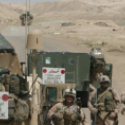The Patton of Counterinsurgency
With a sequence of brilliant offensives, Raymond Odierno adapted the Petraeus doctrine into a successful operational art.
With a sequence of brilliant offensives, Raymond Odierno adapted the Petraeus doctrine into a successful operational art.
In a new AEI report, ISW President Kimberly Kagan, Frederick W. Kagan, and Danielle Pletka present empirical evidence of Iranian activities in its immediate environs.
PowerPoint Presentation by Kimberly Kagan as part of the report, Iranian Influence in the Levant, Iraq, and Afghanistan at the American Enterprise Institute.
The Iraq debate in 2007 focused on whether the new strategy and troop increase could stem violence in Iraq. It did.
In the last six months, violence in Iraq has declined to some of the lowest levels since the conflict began. This document contains MNF-I and MNC-I statistics that chart this reduction in violence.

Summary
As part of a series of interviews with Brigade and Division-level commanders in Iraq, I spoke today with COL Wayne Grigsby, commander of the 3rd HBCT, 3rd Infantry Division (Sledgehammer Brigade) about the clearing of the Mad’ain Qadaa and the continuing fight against both Sunni and Shi'a extremists. You can access the audio and the transcript below.
This document contains graphs and charts released by MNF-I and MNC-I regarding violence in Iraq.
A Corps offensive to prevent al Qaeda, Sunni, and Shi’a insurgent elements from reconstituting their forces in Baghdad, its belts, or elsewhere.
The northeastern belt runs from the Tarmiyah area in the Tigris River Valley, east through Khalis and Baqubah and south to Nahrawan east of Baghdad. It controls the road networks that link Baghdad with the eastern shore of the Tigris River Valley, as well the Diyala River Valley and a key border crossing with Iran. Consequently, both al-Qaeda in Iraq (AQI), Jaysh al-Mahdi, and associated Iranian-backed Special Groups have competed to control the area.